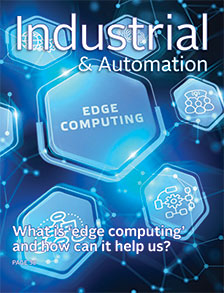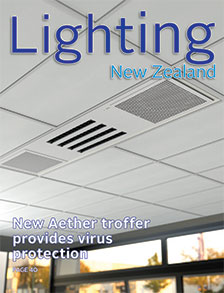Issue 148 March - April 2022Please note: The issue content below is just a summary of the articles in the printed magazine.
The articles are not available on-line.
Please refer to the printed magazine for the complete article.

COVER STORY
Better project support from Active
It has now been ten years since Active Electrical Suppliers opened its first branch and the company continues to grow.
General manager, Kevin Pollock, says this growth has come about because of Active’s commitment to helping its customers grow their own businesses and Active’s unique approach to ensuring that happens.
“We make a big difference with the services we add to product selection and the care we take to ensure jobs and projects are supplied and supported to completion.”
Pollock says Active has spent ten years building strong relationships with electrical contractors and industrial users and making sure they get what they want, when they need it.
“The higher level of stock our managers tailor to the needs of their local customers is just the beginning.”
This extra support starts with how Active has designed its branch network and the investment branch managers make in an ownership stake in their branches.
Not only is Active Electrical Suppliers a New Zealand-owned business, most of its branches are also part owned by its local manager.
This ownership stake pushes decision-making down and out to each branch, so customers are dealing with a local manager and support team who are not only more committed to helping each customer but can also make decisions on the spot to ensure the best result.
Please refer to the printed magazine for the complete article
NEWS
EEA reacts to stepped licensing proposals
The failure of the Electrical Workers Registration Board (EWRB) to consult the Electricity Engineers’ Association on the stepped changes it wants to make to registration classes has drawn a strong rebuke from the EEA.
EEA executive director, Peter Berry, says some of the changes proposed by the EWRB have significant implications for the 70 corporate members of the EEA and many of the 450 individuals who belong to the organisation.
He says because the EWRB did not involve the EEA during the development of its proposed changes, the consultation document the Board released in September 2021 includes changes that do not support the way the electricity supply industry (ESI) needs to train electricians for its specialist applications.
The EEA’s submitted response calls for the EWRB to reconsider some of its proposals in five key areas.
The EEA wants the EWRB to consult with the EEA and ESI representatives with a view to establishing an agreed competency-based training programme for an electrician (electrical fitter) employed within the ESI to carry out PEW on ESI assets.
This would align the work of an ESI electrician with the type of work required, and registration for this class would be based on the attainment of agreed NZQA qualifications and the accumulation of satisfactory skills and experience.
To achieve a similar alignment with the additional competencies needed for ESI work, the EEA wants the EWRB to require any electrical inspector, electrician or electrical engineer who carries out PEW on a HV electrical installation to hold a high voltage (HV) electrical installation endorsement.
Please refer to the printed magazine for the complete article
NEWS
Unlocking distributed generation
For many years power generation was a government-owned monopoly. If we needed more power, we dammed more rivers or built coal or gas-fired generators. The environmental movement opposed all of this, advocating for wind, solar and sustainable generation instead.
But it wasn’t until solar power technology improved to become self-funding that the country began to accept that surplus generation on the other side of the power meter should be integrated into distribution networks.
This new model requires a more consumer-centric approach, and the Sustainable Energy Association New Zealand (SEANZ) was firmly established by 2010 to provide solutions that empower households and businesses to more actively participate on both sides of the energy market.
However, roadblocks at government and network level still provide barriers to the implementation of this new shared model. SEANZ chairman, Brendan Winitana, comments on some changes needed.
If we are going to flatten the demand for large-scale power generation by harnessing the surplus energy generated by consumers, the electricity sector must adapt and provide safe mechanisms for electricity to flow both ways on current networks.
SEANZ is driving this vision through the support and innovation of distributed energy resources (DER). This includes smaller, consumer-owned generation units such as solar photovoltaic, wind generators and battery storage.
By utilising the flexibility that DER provides, we can ensure the safe, secure, reliable, resilient and affordable operation of networks and the market.
Please refer to the printed magazine for the complete article

COVER STORY
What is ‘edge computing’ and how can it help us?
Data is paramount to any organisation, often being its most valuable asset. This is not a new phenomenon as data has always been important to companies, it’s just that we’re now far more ‘digitised’. Digitalisation is the process of moving away from manual, handwritten records, towards using computers to gather, process and store data.
We now use computers more than ever and this in turn is generating ever greater data. In fact, many businesses are using digitalisation as a means of becoming more efficient, and ultimately more competitive. Industry is no exception to this – its digital transformation has been underway for some years now.
The question then of how computers are applied within industry becomes a critical one. If we do not use them correctly, we will fail to gain many of the benefits provided by digitisation.
Please refer to the printed magazine for the complete article
When control cabinets run out of space
You’ve just taken delivery of a nice new shiny industrial control panel. It’s been expertly prepared by professionals who have taken great care to ensure all is in perfect working order. The cabinet is tightly packed with new, high quality electronic componentry.
The fabricators have used as small a cubicle as possible. This is understandable as being compact reduces bulk which eases transport, makes installation easier and reduces costs. But this also means there’s a distinct lack of free space within the cabinet.
All seems to be going well, but then come the inevitable calls for expansion. They arise due to the need for continual improvement and to draw the maximum capability from all available resources. These calls can come as early as the commissioning phase.
Each cycle of expansion almost invariably requires additional connections from field devices, everything from simple I/O to communication ports.
While some capacity for expansion has been allowed for within the control cabinet, this is usually quickly consumed, leaving the user with a distinct lack of space. There’s also no room for mounting additional cabinets – something that would be impractical in any case.
We’ve all been there, and it’s very frustrating. So what can we do about it?
Please refer to the printed magazine for the complete article

COVER STORY
New Aether troffer provides virus protection
s hospitals around the world increasingly use ultraviolet light to destroy airborne pathogens, the lighting industry is responding with new solutions that bring UV air purification into standard lighting designs.
Covid has accelerated this demand but the technology will deliver protection against many airborne threats long after the panic over Covid has subsided.
Typically, ultra violet (UV) devices are being developed as standalone systems or appliances. Lighting company Pierlite, however, has taken a different approach that will safely deliver clean air to offices as a simple troffer retrofit and LED lighting upgrade.
Pierlite is now launching Aether, as the first LED T-Rail troffer to incorporate UV-C technology in a light-trapping disinfection chamber that deactivates pathogens as a 22 watt DC fan pushes air through it.
Pierlite’s general manager of sales and marketing, Garth Mudford, says Aether is designed to operate over a 24/7 cycle so that office staff can come to work in the morning knowing the office air has been cleansed and viruses like the flu and Covid have been neutralised.
He says a single pass through the Aether fitting will deactivate 99.995 percent of virus particles so anyone coming into the workspace with a respiratory illness like Covid, will be far less likely to transmit it to anyone else because an Aether installation can treat all the air in a room up to four cycles an hour with a clean air delivery rate of 47 litres a second.
Please refer to the printed magazine for the complete article
Lighting for health - the new revolution
If you haven’t heard of it yet, then be prepared, it will soon be coming to a lighting conversation near you. It comes under many names including, circadian, human centric (HCL), colour tuneable, intensity tuning or stimulus lighting. It is even referenced as a part of another new age term, biophilia (being one with nature).
So, what do all these terms have in common and what are they trying to achieve? It’s not actually that new, it is the recognition that our move away from people being exposed to natural light has lessened as two factors have come to have a more prevalent role in our lives: the introduction of artificial lighting teamed with people spending larger proportions of their day inside and devoid of natural light sources.
Original research, focused on that of circadian rhythms and seasonal affective disorder (SAD), were the two major fields that have brought the interest in lighting for health to the forefront of the lighting industry. SAD, where people can display depressive symptoms usually over autumn and winter was heavily studied from the 1980’s onwards. It is especially pronounced in countries that have long periods of darkness during winter.
Please refer to the printed magazine for the complete article
The pathway to better lighting solutions
While electrical installations typically serve their function simply by working, lighting installations not only have to work, they also have to be designed to beneficially influence our behaviour and comfort in their use. Better lighting creates better responses every day and night, adding more value in its use over the life of the installation than any amount of cost savings in its selection and installation.
But we have no metrics to measure this significant benefit to our clients and to factor it into project pricing. All too often, the electrical wholesaler competitive model strips such considerations out in the race to the bottom-line cost of a project.
Many clients never get the option of better lighting being put to them despite the best endeavours of motivated people in various sectors of the lighting industry.
Designer Roger Golding looks at the issues designers, specifiers, installers, suppliers and wholesalers face, and how the path to better lighting begins with increased lighting knowledge and more effective engagement with the end-customer.
If you were a client, what lighting would you want for your business or home? It’s a simple list, functional, technologically up to date, low maintenance, highly efficient and environmentally friendly – all within budget.
So how do we set about achieving this. The path to market for lighting infrastructure is mainly distributed from two sources, that of the electrical contractor and that of specifiers like architects, engineers, and lighting designers, both of which are typically funnelled through an electrical wholesaler at the point of distribution. The domestic and the commercial/industrial markets each have specific requirements and different flows to market.
Please refer to the printed magazine for the complete article
|